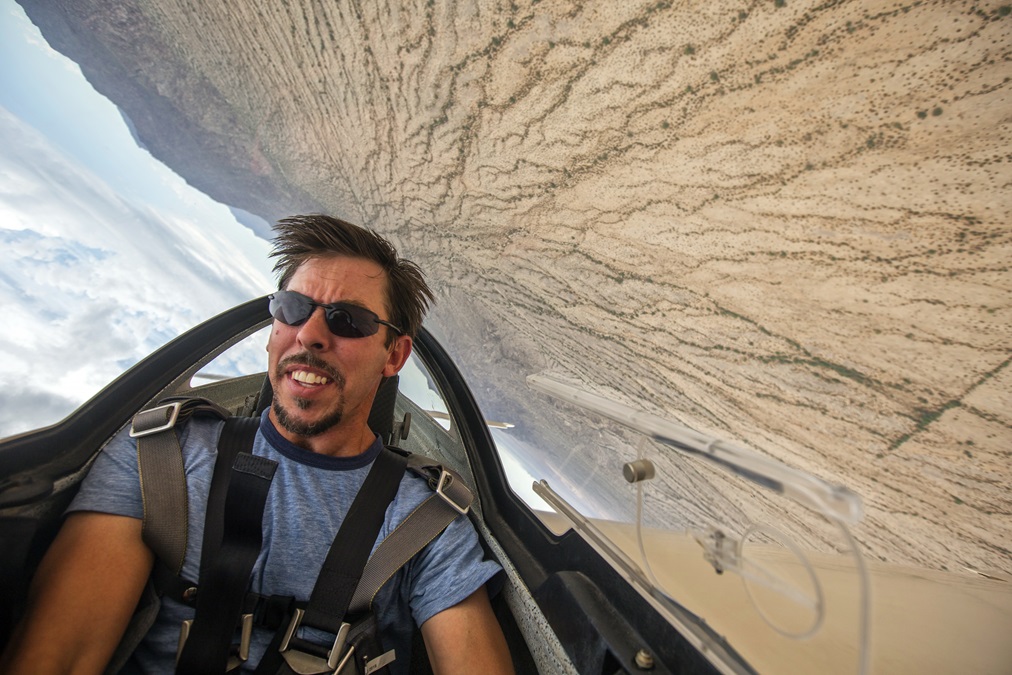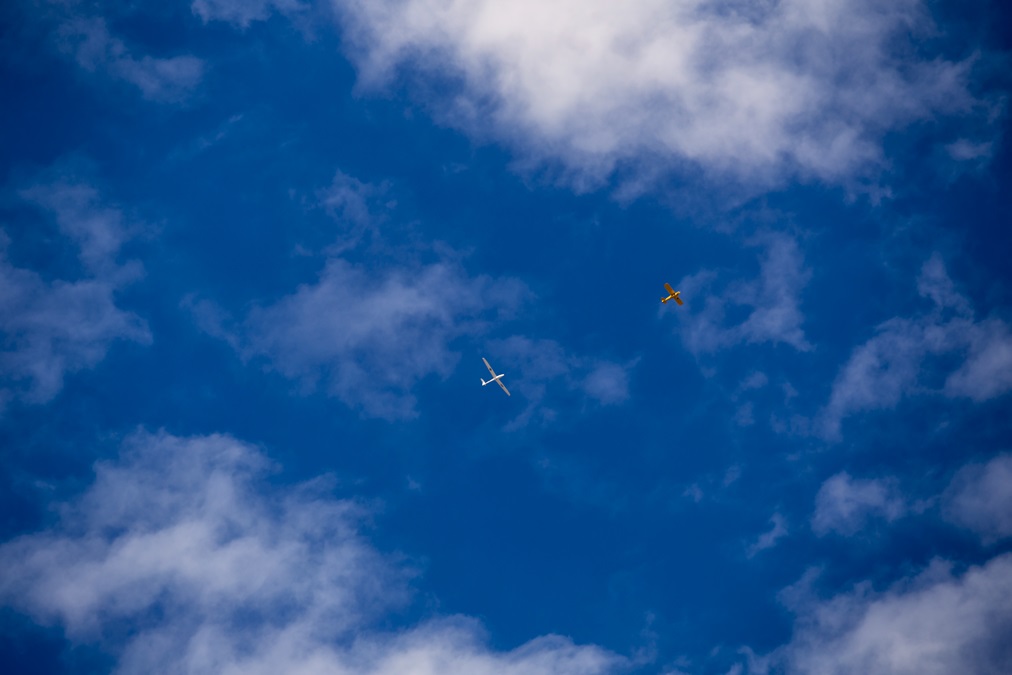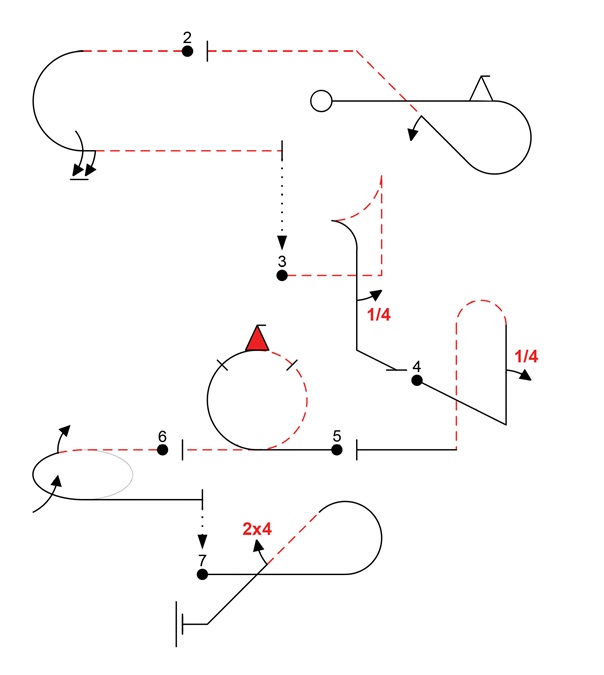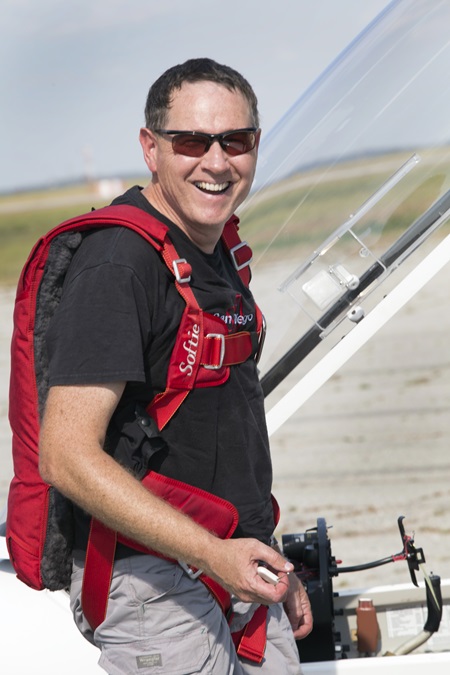Zen masters
Aerobatics without engines
The pilot spoke sparingly, working his way through combinations of loops, snaps, and rolls—including one particularly memorable push (here come the negative Gs) from inverted to a vertical upline that tested the strength of the safety harness, then back down into a tailslide that tested the strength of the tail. The pilot might have hummed a little, seeming relaxed, almost casual as the G-meter swung to and fro. I knew without turning my head that he was consulting, on his cellphone, a diagram of the International Aerobatic Club’s 2015 Unlimited Glider Known program, which he had not studied much, even though the national championships were just a couple of weeks away.
As a fledgling aerobatic pilot in powered aircraft, I’m used to calling out each figure (maneuver) as it comes up, speaking out loud in part to keep the mind focused and in part to avoid flying the wrong figure. Jason Stephens, the most accomplished American competition aerobatic glider pilot of his generation, dispensed with all that talking. It made each push, pull, roll, and loop a lively surprise.
Perhaps the greatest of these surprises was the silence. A glider makes more noise than you might think as it slices through air at speed—but as we climbed on a vertical line to the point where kinetic energy was exhausted, and then slipped backward into a tailslide, there was, for an instant, simply silence. At the apex, with a vista of mountains and desert etched by countless tiny, dry riverbeds below, not even a creak from the airframe nor whisper of wind was audible.
The relative quiet of the cockpit even when a glider is moving at speed is the most obvious difference from flying aerobatics in a powered aircraft, although there are subtler differences, too. Stephens pointed out some of these later, after demonstrating a hammerhead with the altitude left over when the competition sequence was complete. A Super Decathlon shudders as it reaches the top of a vertical upline, signaling the critical moment when the pilot must use the rudder to begin the hammerhead pivot or risk a dangerous (for a Decathlon) tailslide; the glider seemed to offer no such clues.
It is different for a practiced ear: Stephens said he can tell when it’s time to kick by the sound.
“It’s talking to you, but in different ways than a Decathlon would,” Stephens said after the flight. “With the glider, it’s more about the sound.”
A rare skill
Perhaps no other flying discipline requires such singular focus on subtlety. The pilot is tuned to the moment, taking in the smallest vibrations, stick forces, and the sights outside, and managing carefully the exchange of energy between potential and kinetic. There is no room for waste. Stephens said that although many judges favor tight turns and arcs, he is wary of pulling more than 5 Gs, or pushing more than 4; the price paid in energy is too great.
Stephens soloed a glider at age 14, taught in his high school years by Les Horvath, a Hungarian immigrant who won national titles in aerobatic and other glider disciplines. In 1969, Horvath founded Arizona Soaring, a school Stephens’ family purchased in 1987 and operates today. (The trophy awarded to the national champion in glider aerobatics has been named in Horvath’s honor since 1992, recognizing his important role in building the sport. It is a prize Stephens has won five times.)
Aerobatics, Stephens said, requires both precision and a smooth touch. Finding that touch in the cockpit helped smooth his own rough edges and gain control of the wild side he once had as an Alaska-born teen transplanted to Arizona. He started giving aerobatic rides as a high school senior, and worked on weekends as a tow pilot while studying at Arizona State University. Stephens did not begin competing in aerobatics until the late 1990s, entering a local IAC chapter contest, the Tequila Cup. Soon after that, he said, “we bought our Fox.”
With a Fox to fly, many things were possible.
The Margański-Dunowski-Makula MDM–1 Fox is capable of +9/-6 Gs in solo flight. It is one of two gliders usually flown in top-level (Unlimited) world competition; the single-seat Swift S–1 is the other. Aerobatic gliders have shorter wingspans than gliders made to soar, in part to increase a roll rate that remains glacial compared to a powered aerobatic airplane such as an Extra. The ability to handle high G-loads is another design requirement.
Stephens also received tutelage from seven-time world champion Jerzy Makula, who encouraged the young American to try his hand against the best in the world at the world championships in Austria in 2007.
American pilots have fallen short of the world championship podium, both as individuals and as teams, since a U.S. team took third place at the Fédération Aéronautique Internationale World Glider Aerobatic Championships in 1991. Very few Americans have even made the attempt. That has a lot to do with a national shortage of pilots with the required training, and of gliders capable of performing the required maneuvers (there are six MDM Fox models and three Swift S–1s in the FAA registry). There are precious few instructors like Stephens with the expertise required to prepare students to excel at the top levels, and few places to train for this exotic aeronautical discipline. Only two schools in the country—Arizona Soaring and Williams Soaring Center in California—offer instruction in a Fox.
The latter school is the flying home of Eric Lentz-Gauthier, who would square off against Stephens in the aerobatic box at the 2015 International Aerobatic Club U.S. National Aerobatic Championships in September, two weeks after Stephens demonstrated the Unlimited Known sequence over Arizona. The two of them—and Lukas von Atzigen, a Swiss-born resident of Tennessee—comprised the entire field in the Unlimited Glider category during the competition held at the former Air Force base in Texas.
Competition
The hot Texas sun brought shimmering waves of heat from the ramps and runways at North Texas Regional Airport, forcing pilots to find refuge in shade during the long waits between flights at the national championships, where gliders and powered aircraft took turns in the competition box.
On one side of the field, Extras, Pitts Specials, Staudachers, and Super Decathlons—dozens of aircraft in all—were pulled each morning from hangars to take their places in line. On the other side of the sprawling airfield, a much smaller collection of gliders had ample elbow room in the hangar or on the line. Competitors share the gliders as a matter of both custom and necessity.
The three pilots vying for the championship were joined by two flying in the IAC Advanced category, one level below Unlimited: Guy Acheson and Mallory Lynch, both of whom trained at Williams Soaring. Nearby, a dozen cadet pilots from the U.S. Air Force Academy team, along with their leaders and family members, filled out the ranks of the Intermediate and Sportsman categories, flying two-seat DG–1001 gliders, designated the TG–16A in the military inventory.
In a broad sense, every aerobatic glider pilot is a member of a team: competitors in the box but friends who support, coach, and encourage one another the rest of the time. Being part of such a small community within a small community, they exchange flight videos over the internet and share tips and techniques. Lynch said Williams Soaring benefits from strong support from the owners and a shared community commitment to safety and training.
“Everybody works together,” Lynch said. “I came up, basically from nothing, in a year and a half.”
Lentz-Gauthier, he added, “has been an unbelievably good coach. It’s more than an airport, it’s a family. It really is a family.”
Stephens came up short in his quest for a sixth championship, done in by the omission of the fourth figure in the Unknown sequence, which is given to each pilot during the contest and must be flown without practice. Lentz-Gauthier claimed the Les Horvath Trophy by making no such mistakes, a steady and consistent march of mastery through three flights. Von Atzigen shone during the four-minute freestyle, the only glider pilot to enter that stand-alone event, which does not count toward the trophy. Canisters of colored smoke traced curves and lines from his wing tips as he danced in the sky to Time To Say Goodbye, recorded by Andrea Bocelli and Sarah Brightman. Gliders cannot compete with high-powered composite monoplanes when it comes to dynamic maneuvers and speed, but they give up nothing in grace.
This month, Stephens and Lentz-Gauthier will meet again as rivals in Hungary during the Nineteenth World Glider Aerobatic Championships. In 2015, Lentz-Gauthier finished fifth overall (Stephens did not make the trip to the Czech Republic), and a podium finish is potentially within reach for both. Perhaps, if they keep their focus sharp and listen carefully to every subtle nuance, if they fly smooth and precise, even a championship—which would be a first for an American pilot.
“Ultimately, your only competition is yourself, anyway,” Stephens said. “I wish I had learned that a long time ago.”
Email [email protected]
High stakes, high standards
Air Force cadets put their skills to the test
At the 2015 International Aerobatic Club U.S. National Aerobatic Championships, the seniors on the U.S. Air Force Academy team had more on their minds than the next sequence: News of their flight assignments, which would chart the course of their careers as officers, was scheduled to arrive in the middle of the contest.
“You definitely have to compartmentalize,” said senior cadet Norman C. Hitosis, who hoped to land a slot that would lead to the F–22 Raptor. “I just want to fly something fast and pointy, sir,” Hitosis said.
The gliders the cadets flew in Texas were neither of those things, although they arguably were the better training platforms for it.
The Air Force has for years supplied the vast majority of competitors in the glider categories at the national championships. Members of the 94th Flight Training Squadron also serve as the youngest instructors in the Air Force, teaching fellow cadets the basics in gliders while honing their own skills.
“I honestly do believe that the experience we gain flying these gliders in an aerobatic profile pays off a lot,” Hitosis said. “The amount that you can deviate is so small, you just hold yourself to a much higher standard. It only takes one mistake for you to be brought from the first place down to the last place.” —JM










